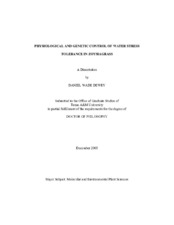| dc.description.abstract | Significant cultivar difference in many water stress responses of zoysiagrass
(Zoysia japonica (Steud.) and Zoysia matrella (L.) Merr.) are shown in this study. Of the
four cultivars, Palisades was the most water stress tolerant, had the most negative turgor
loss point, and leaf rolled after loss of full turgor pressure. On the other end of the
spectrum, Diamond was the least water stress tolerant, had the lowest full turgor pressure,
the least negative turgor loss point, and leaf rolled at full turgor. Differences between
Diamond, Cavalier, Palisades, and DALZ 8504 in leaf rolling, loss of full turgor, water
release curve parameters, root characteristics and gene expression make zoysiagrass a
prime candidate for further investigation into the mechanisms of water stress
avoidance/tolerance. Enhanced antioxidant activity and stomatal control, along with root
characteristics, most likely explain the cultivar difference in water stress tolerance of
zoysiagrass. Palisades and DALZ 8504 maintained full turgor for significantly longer
than Diamond and Cavalier, which may be associated with root characteristics and/or
enhanced stomatal control as only those two cultivars showed enhanced expression of a
stomatal control gene (phospholipase D). The apparent response (most apparent in turgid
weight/dry weight ratios (TWDW)) of well watered plants to water stressed neighbor plants will likely be the most novel finding of this study. Well watered zoysiagrass and
Kentucky bluegrass responded to water stressed neighbors by reducing TWDW.
Significant increases in gene expression of a systemin degrading enzyme and of an
integral membrane protein (signal receptor) were also observed in well watered plants.
Results from this study indicate that this phenomenon is occurring and expose a dearth in
scientific understanding that must be filled. Improving water stress tolerance through
breeding for parameters like those discussed in this paper (delayed leaf rolling or loss of
full turgor, enhanced stomatal control, enhanced antioxidant activity, deep rooting
characteristics, etc.) may very likely produce turfgrasses that can survive and maintain
desired aesthetic qualities using significantly less water. | en |


